| < Prev |
|---|
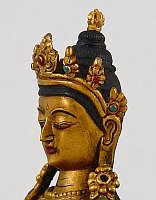 They are called Nepal Bronzes or Tibetan Statues. Both names are a bit misleading. It is an art form for which the Newar artists in Nepal have been famous for from Middle Ages until our days. And the metal used for these unique, all handmade statues is not bronze, but mostly copper - sometimes also brass or various alloys. This articles describes how these metal art works are created by the method of "lost wax form" (Cire Perdue).
They are called Nepal Bronzes or Tibetan Statues. Both names are a bit misleading. It is an art form for which the Newar artists in Nepal have been famous for from Middle Ages until our days. And the metal used for these unique, all handmade statues is not bronze, but mostly copper - sometimes also brass or various alloys. This articles describes how these metal art works are created by the method of "lost wax form" (Cire Perdue).
Patan in Nepal
When Buddhism came to the Himalayan region, the art of metal processing was already at a high standard in Nepal. During the twelfth century an important Buddhist community of scholars had been established in Patan, then a small town in Kathmandu valley. Patan soon became the cradle for Buddhist art and crafts. The Newar artists enjoyed a great reputation and several family clans began to produce Buddhist metal statues by the principle of CIRE PERDUE (lost wax form). These metal statues were exported throughout the Himalayan region - to Tibet, India, China and other countries.
Since then the all-handmade production process and the families involved have not changed much. Only the market has changed. Today these artisan works are less produced for religious worship but for art collectors and for the high-end tourist market.
How to Make a Metal Statue
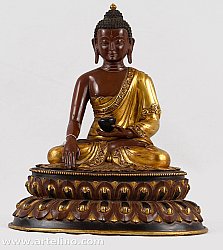 There are basically three methods to create metal statues. The first is from a firm mold which can be used to create a great number of pieces. As they all come from the same mold, each piece is the same. This process allows a kind of mass production. The second method is the "repousse" method. It consists of hammering metal into a desired form. This method is used for very large statues and in architecture.
There are basically three methods to create metal statues. The first is from a firm mold which can be used to create a great number of pieces. As they all come from the same mold, each piece is the same. This process allows a kind of mass production. The second method is the "repousse" method. It consists of hammering metal into a desired form. This method is used for very large statues and in architecture.
Finally the third method is the CIRE PERDUE method. It is the method that has been used by the Newar artisans since at least the eleventh century. Maybe it goes back to the sixth century and was imported from India. Still today the artisans use an old text which describes the details of the process. These written "How to do guides" are inherited within the artisan families and are kept secret.
Cire Perdue Method
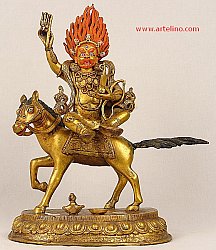 With the "Cire Perdue" method, first a model of bee wax is made. Once the model is finished, the wax is covered with clay. The wax-clay model then has to be dried out for several weeks.
With the "Cire Perdue" method, first a model of bee wax is made. Once the model is finished, the wax is covered with clay. The wax-clay model then has to be dried out for several weeks.
When the clay has sufficiently hardened, next the wax is melted out. Hot metal is poured into the mold cavity. Thus the rough cast is obtained. The method makes sure that each statue is a unique, hand-made metal piece.
With the method described above, a solid statue of metal would be obtained. As this would be too expensive in terms of metal use, larger statues are created in a refined technique that keeps the cast hollow inside. Only small statues are cast in solid metal.
The more elaborate statues, for instance of gods or goddesses with a dozen or more arms, are made of several separate parts. This requires careful planning and modeling by the artisan.
Carving and Polishing
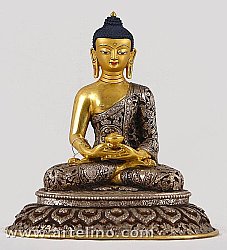 After the metal casting the statue is by far not yet finished. The cast figurine is still rough. Now the fine details have to be chiseled into the metal. This can take weeks and the quality of this work makes the difference between average and excellent pieces. The best pieces have intricate, detailed patterns applied also to the back of a statue.
After the metal casting the statue is by far not yet finished. The cast figurine is still rough. Now the fine details have to be chiseled into the metal. This can take weeks and the quality of this work makes the difference between average and excellent pieces. The best pieces have intricate, detailed patterns applied also to the back of a statue.
Among experts the real work and challenge is in the final carving and not in the casting. That is also the reason why copper is used for the best statues. It is the most suitable metal for carving. The use of copper is by the way not recent. The oldest copper statues from Patan date back to the 6th century.
When the carving is done, the surface is polished to give it a smooth and clean impression.
Applying Gold
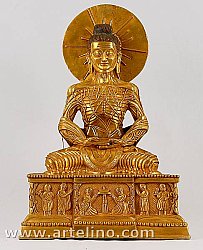 The best and most expensive statues are applied with pure gold. Extremely thin sheets of gold are applied on the surface and are melted into the metal using fire. Statues that were gilded with this method are called "gold-plated". It is the best method but the more time-consuming and difficult one.
The best and most expensive statues are applied with pure gold. Extremely thin sheets of gold are applied on the surface and are melted into the metal using fire. Statues that were gilded with this method are called "gold-plated". It is the best method but the more time-consuming and difficult one.
Gold can also be melted into the metal with a mercury process. There is only the second best method and used for cheaper statues. The amount of gold used is lower for the mercury method. And the final glamor of gold-gilded statues by the mercury method is less intensive.
Refinement and Final Touch
After applying the gold, the statue can be further refined by adding semi-precious stones and iconographic, delicate painting. The paint is preferably applied to the faces and the hair of the god or goddess.
By tradition Nepal statues are not signed by the artist. It would be against the Buddhist tradition and the understanding of the artist himself as skillful artisan. Also thangkas, another high-quality craft from Nepal and Tibet, are not signed.
Great Value for your Bucks
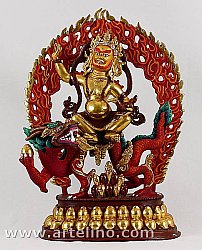 I have been numerous times in Nepal since the late seventies of the nineteenth century. My most recent visit was in January of 2008. I do not know of any other place in the world where you can buy art and crafts (statues, thangkas, hand-made carpets and hand-carved furniture) on such a high quality level for so little money as in Nepal. This is only possible because Nepal is among the poorest countries in this world.
I have been numerous times in Nepal since the late seventies of the nineteenth century. My most recent visit was in January of 2008. I do not know of any other place in the world where you can buy art and crafts (statues, thangkas, hand-made carpets and hand-carved furniture) on such a high quality level for so little money as in Nepal. This is only possible because Nepal is among the poorest countries in this world.
Over the last years this former kingdom has been ravaged by a grim civil war. As a consequence the flux of tourists has dwindled to a very small number. And the export of Nepalese handicraft goods has declined as well over the recent years.
Also the Newar metal artisans who have preserved their craft over centuries, are now faced with dwindling demand. Many Nepalese men are seeking for work in the Arab countries as low paid workforce to keep their families alive. When I was in Kathmandu in January, I was told that quite a few of the metal artisans from Patan have emigrated to China where they found a new market for their ancient trade.
Dieter Wanczura







